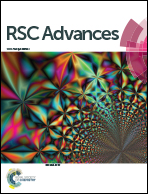TiO2/nanoporous silicon hybrid contact for heterojunction crystalline solar cell†
Abstract
The conventional solar cell architectures include a p–n junction of c-Si sandwiched by rear and front contacts. The conventional approach features a complex as well as expensive procedure. Here, we propose a new architecture for p–n heterojunction solar cells prepared by a simple and cost-effective procedure. In this regard, (1) a silicon wafer underwent surface treatment through electrochemical anodization. To prepare a stick junction, (2) photoactive TiO2 nanoparticles were deposited over the porous layer by electrophoretic technique. Finally, (3) indium tin oxide (ITO) was sputtered. During the fabrication steps, we examined various anodization times ranging from 6 to 12 min to study the electrical behavior of the proposed device. Current–voltage measurements revealed higher performance for the 6 min sample, with a short circuit current density and open circuit voltage of 29.632 mA cm−2 and 0.5 V, respectively. Also, morphology study showed uneven surface over the fabricated sample. Measurement of the optical properties showed potential anti-reflection surfaces. However, the 6 min sample, with an average reflectance of 1.9%, proved to be the competitive one. In addition, absorption data revealed a band gap of 1.38 eV for the 6 min sample, which is broader than that of others. Also, PL measurements explain the effective charge transfer for the lowest duration of anodization.


 Please wait while we load your content...
Please wait while we load your content...